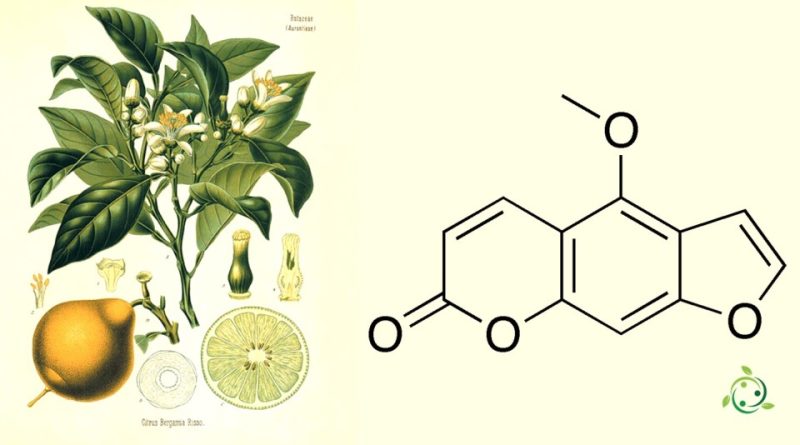Bergapten
Bergapten
Bergapten, whose term in the official IUPAC nomenclature is: 5-methoxy-2H-furo[3,2-g]cromen-2-one, is a natural substance that belongs to a class of chemical compounds known as furanocoumarins.
Bergapten has a brute or molecular formula: C12H8O4 and is also known by the name of 5-methoxypsoralen.
Bergapten is an organic chemical compound present in nature and produced by numerous plant species, in particular by the carrot family (Apiaceae) and by the citrus family (Rutaceae).
Bergapten was extracted from 24 species of the Heracleum genus of the Apiaceae family. In the Rutaceae family, various citrus species contain significant amounts of bergapten, particularly bergamot, micrantha, and some varieties of lime and bitter orange.
It was first isolated in 1834 by Kalbrunner who isolated it from the essential oil of bergamot, hence the common name bergapten. This natural substance was the first furanocoumarin to be isolated and identified.
Bergapten is a derivative of psoralen, the parent compound of a family of naturally occurring organic compounds known as linear furanocoumarins (so called because they have a linear chemical structure). Some of the linear furanocoumarins, including bergapten, act as strong photosensitizers when applied topically to the skin.
Bergapten is often found in plants associated with phytophotodermatitis, a potentially serious skin inflammation. Contact with plant parts containing bergapten (and other linear furanocoumarins) followed by exposure to ultraviolet light can lead to phytophotodermatitis. In particular, bergapten appears to be the main phototoxic compound responsible for citrus-induced phytophotodermatitis.
Bergapten and other linear furanocoumarins induce a loss of template activity for RNA synthesis. 5-Methoxypsoralen has also been noted for its mutagenic effects and its ability to be a very potent agent for inducing chromosomal aberrations. With a high enough concentration, complete mitotic inhibition was observed.
There is sufficient evidence that bergapten promotes cancer in animals, but evidence of carcinogenicity in humans is lacking. According to the International Agency for Research on Cancer, bergapten is probably carcinogenic to humans.
Bergapten has various medical applications.
It contributes to the increased absorption of solar radiation on the skin, contributing to the treatment of pigmentary diseases such as vitiligo (leukoderma) and psoriasis.
Bergapten has been shown to elicit some skin reactions in order to even out pigmentation lightening for Vitiligo patients depending on various factors such as subject susceptibility, dosage, and humidity, but the effects may be inconsistent.
It functions as a photosensitizing drug that is as effective or, with a high enough dosage, more effective than 8-methoxypsoralen in clearing psoriasis lesions. It has been shown to be a viable alternative to 8-methoxypsoralen due to the relative lack of side effects during treatment such as erythema, itching and nausea.
Bergapten has also been indicated as a potential prevention method for sunlight-related skin cancer. One study found that tanning acquired with bergapten resulted in less DNA damage in human subjects. Bergapten has been shown to have anticancer effects, such as its ability to induce the autophagic process in breast cancer cells.
Other properties and applications are under development.
Warning: The information provided is not medical advice and may not be accurate. The contents are for illustrative purposes only and do not replace medical advice.

